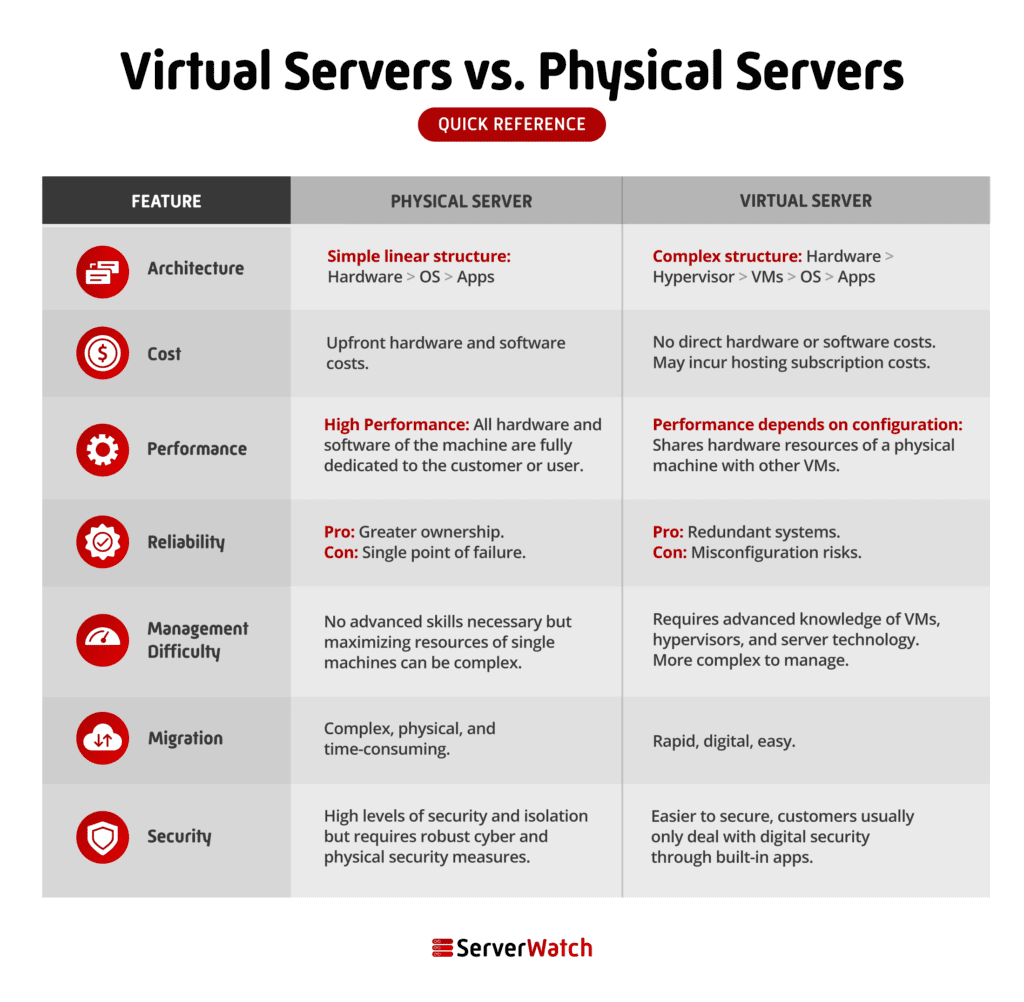

The terms “virtual server” and “physical server” do not refer to a state of tangible or intangible existence but rather to the way the machines are structured.
All digital data and systems have to exist and be hosted somewhere in the real world. A platform that runs on the cloud, your personal accounts, a company website you visit online, or an app on your phone can all be traced back to where they are hosted: a real machine.
With that said, let’s look at two short standard definitions of both terms before we dive into the technology behind them.
A physical server is any machine with chassis, CPU, GPU, RAM, storage, its power supply unit, network interface, OS, server application software, and other software. Physical servers are typically designed to run 24/7, and are not used for general computing but rather to run applications that serve other computers, such as web servers, hosting, or other server tasks.
No matter what size that machine is, whether a small desktop computer or a large rack-mounted server, and no matter where it is located, it will always be a physical server. Technically these types of machines are also called bare metal servers. Bare metal servers can be operated privately by organizations at their own locations, or accessed through top cloud vendors.
The most important difference between physical and virtual servers is that the former retain all the resources of the machine exclusively for themselves. This makes physical servers extremely secure and very powerful. Key features include of physical servers include:
In the early 2000s, the large majority of servers in the world were physical servers. This means that digital systems were powered by “individual” machines, usually each company hosting their own to drive their IT systems.
Today, the scale has shifted and VMs run the majority of global server workloads. However, physical servers still have a place in the modern IT infrastructure and they are used for a variety of demanding workloads.
Popular use cases for physical servers include:
Industries that put the use cases of physical servers to work include financial services, healthcare, government and defense, aerospace, logistics, public services and utilities, manufacturing, and media and entertainment. These sectors value the reliability, performance, security, isolation, and ownership that physical servers provide.
A virtual server is a digital replica of a physical server, usually created using only a fraction of the resources of the original physical server in order to power many identical virtual servers on the same hardware. Virtualization is the key to cloud computing and how big tech can offer efficient resources at global scales while maximizing their hardware.
Imagine you had a large rack mounted with all the state-of-the-art hardware and software needed to run a modern server. This machine has significant computing power, lots of storage, incredible speed, reliability, and security.
A customer comes along and wants to rent out your machine to host a site.
But then two more customers come in and want to rent your machine to manage a database. So you transform that rack-mounted physical server into a virtual server, creating several VMs that share the resources of the machine.
Each VM is assigned its own dedicated resources, such as CPU, memory, and storage. Each VM will then become a virtual server, running as an isolated system within the physical host.
At a larger scale, this exact scenario is driving the growth and scale of cloud computing.
There are several key features unique to virtual servers. These include:
The use cases of virtual servers are essentially endless. They are used intensely by every industry for all kinds of applications. Even regular users will engage with virtual servers every day without even knowing it as they browse online and log in to their platforms and digital accounts.
Some popular use cases for virtual servers include:
In addition to these common use cases, virtual servers can also be used for a variety of other purposes including virtual desktops, cloud computing, HPC, and many others.
Here’s a closer look at the differences and comparisons between physical and virtual servers.

The main difference between physical and virtual servers, as mentioned in the introduction, is how the machines are structured, in other words, their architecture.
Virtualization technology tends to be more complex, and in some way more advanced, than physical servers — but it is also more cost-efficient when purchased at scale.
Besides the hardware and software costs, usually when using a virtual server, companies are not responsible for its maintenance. If the hardware of a virtual server breaks down you will probably not even know about it as the vendor will make the switch rapidly. Physical break-ins, theft of hardware, server energy bills, or natural disasters, fires, floods, or earthquakes, are things that virtual server users — who opt for cloud virtualization vendors — also do not have to worry about.
When it comes to performance it is a tight race between physical and virtual servers. The truth is that there are several factors that will determine which of these systems will outperform the other. Configurations, hardware and computing capacities, software and network, are some of the issues that define performance server performance.
Just like performance, reliability will depend on the machine, the software, the networks, and the configurations. Both physical and virtual servers can be set up to be extremely reliable, in different ways and for different reasons.
Server management for both physical and virtual servers can be complex — though if you are operating a virtual server from an external provider, most of those tasks will be outsourced to the vendor.
It is easier to migrate virtual servers than physical servers. This is because virtual servers can be easily copied from one physical server to another. Users can migrate a VM in just a couple of clicks.
In contrast, physical servers need to be physically moved and reconfigured. This means manually backing up the entire system and loading it into a new machine.
Both virtual servers and physical servers can be secure, but they require careful configuration and management. Additionally, both technologies offer some level of isolation.
Virtual servers and physical servers both have their own advantages and disadvantages. The best choice for your business will depend on your specific needs and requirements.
Overall, virtual servers are a good choice for most businesses. They are affordable, offer excellent reliability and access to the latest tech, and are extremely scalable. However, physical servers may be a better choice for businesses that need greater ownership, higher performance, and airtight security.
Explore our analysis of the best server virtualization software to start taking advantage of the latest advances in virtualization technology.


Ray is a Content and Communications Specialist with more than 15 years of experience. He currently works at Publicize and as a contributing writer for TechRepublic, eSecurityPlanet, and Enterprise Networking Planet in addition to ServerWatch. His work has also been published in Microsoft, Venture Beat, Forbes, Entrepreneur, The Sunday Mail, FinTech Times, Spiceworks, Dice Insights, Horasis, the Nature Conservancy, and other leading publications.
Property of TechnologyAdvice. © 2025 TechnologyAdvice. All Rights Reserved
Advertiser Disclosure: Some of the products that appear on this site are from companies from which TechnologyAdvice receives compensation. This compensation may impact how and where products appear on this site including, for example, the order in which they appear. TechnologyAdvice does not include all companies or all types of products available in the marketplace.